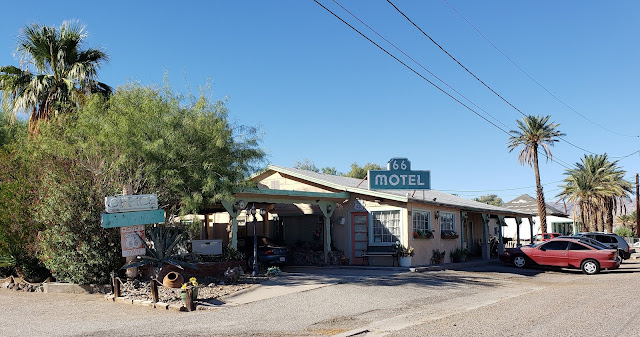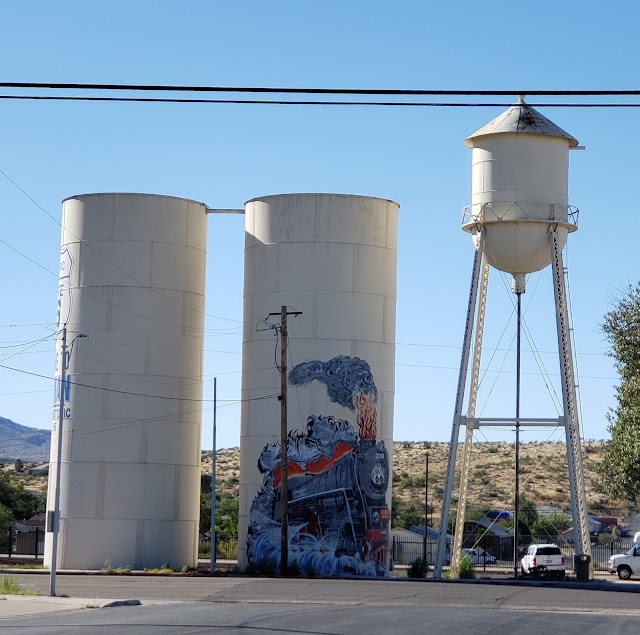The Oatman Highway (AZ 10) ends just after passing the town of Topock, Arizona. As the road approaches I-40, it curves right (west) to briefly parallel railroad tracks. It then makes a hairpin turn to cross under the railroad tracks, then go east between the railroad and I-40. Here, on the north side of the road next to the railroad tracks, is a water tower built in 1908.
 |
| Topock Water Tower |
When AZ 10 crosses I-40, the long unbroken stretch of original Route 66, which began east of Seligman, Arizona, ends. You must get on I-40 to cross the Colorado River and enter California. But, if you can safely pause on the overpass over I-40, you can see two sights. To the east are some mountains called The Needles. They appeared in the movies The Grapes of Wrath and Easy Rider.
 |
| The Needles, south of Topock |
And to the west is a beautiful bridge.
 |
| Old Trails Bridge near Topock |
This bridge was built in 1916, a decade before the National Old Trails Highway became Route 66. I’ve seen it called the Old Trails Bridge, Trail Arch Bridge, and Old Trails Arch Bridge. Today it only carries a pipeline; it is closed to traffic and pedestrians.
Instead of getting on I-40 into California, we took a detour off Route 66. We went east on I-40 to Exit 9 (AZ 95), then took AZ 95 south to Lake Havasu City, Arizona. Lake Havasu is a real contrast from Route 66, because it was created in 1963, decades after Route 66 was established. It’s most famous as the home of London Bridge, which was installed here in 1971.
 |
| London Bridge in Lake Havasu City |
 |
| London Bridge at night |
The next morning we backtracked to I-40 west, now crossing the Colorado River and entering California. (Tip: Get gas before entering California—it’s much more expensive there.)
We wanted to take the original 1930s Route 66 alignment to Needles, so about a mile after crossing into California, we took the exit for Park Moabi Road, turning right (north) onto Park Moabi Road. In about a mile, we turned left (west) on National Trails Highway—the original Route 66. We soon encountered this:
 |
| National Trails Highway west of Park Moabi Road |
At the time, we thought National Trails Highway was blocked off. Afterwards, I studied my maps again and I now think National Trails Highway veers left, crossing under the railroad tracks. No matter—it would have been far too rough for us to feel comfortable driving. So we backtracked to I-40 and continued west on I-40 to the exit for Five Mile Road. We turned left (west) on Five Mile Road. Here the National Trails Highway that we wanted to drive merges into Five Mile Road, so we were back on the 1930s Route 66 alignment. In about a mile, Five Mile Road merges into US 95—still the 1930s Route 66 alignment.
 |
| US 95 (1930s Route 66 alignment) south of Needles |
We continued on US 95 north about five miles into Needles,
California. Here US 95 (Route 66) becomes Broadway Street.
Just off Route 66, at 91 Desnok Street, is the adorable 66 Motel, built in 1945-1947.
 |
| 66 Motel in Needles |
The 66 Motel has a great old sign on Route 66, pointing travelers to the motel.
 |
| 66 Motel sign |
About 3 blocks north of the 66 Motel on Route 66, just past Palm Way, is the former Old Trails Inn. It opened in the 1930s as the Palms Motel.
 |
| Former Palms Motel in Needles |
Across Route 66 from the Old Trails Inn, a borax wagon welcomes visitors to Needles.
 |
| Borax wagon in Needles |
The wagon is a tribute to the wagons that once hauled borax out of nearby mines. (We’re old enough to remember TV commercials for “20 Mule Team Borax.”) This wagon was once in front of the long-gone El Rancho Motel a bit north of here.
Four blocks north of the borax wagon is a beautiful 1930s art deco building at 725 West Broadway Street.
 |
| Former Claypool & Company Hardware |
The building once housed Claypool & Company Hardware. Today it houses Palo Verde Community College.
A block past the Claypool building, we turned right on F Street, then left on Quinn Court. On the right (north) side of Quinn Court is the beautiful El Garces Hotel.
 |
| El Garces Hotel |
The El Garces Hotel was built in 1908 to replace a train depot that burned. It was designed to look like a Greek temple. It was one of the Harvey House chain built primarily to serve railroad passengers. (See my post on Winslow for more information on the Harvey Houses.) It is open for tours by appointment only; inquire at the Needles Regional Museum across the street.
On the north corner of the park in front of the hotel is a great sign honoring both Route 66 and Needles' railroad heritage.
 |
| Route 66 sign in front of El Garces Hotel |
And across Quinn Court from the hotel is a Route 66 gem: the Needles Regional Museum in a former J.C. Penney’s department store.
 |
| Needles Regional Museum |
The building has a great mural on its right (north) side.
 |
| Needles Regional Museum mural |
The museum itself is a wonderful Route 66 stop. At the entrance is a statue of Spike, Snoopy’s brother.
 |
| Spike (and a lot of other cool stuff) at the Needles Regional Museum |
Charles Schulz, who created the Peanuts comic strip, lived in Needles as a child for a few years. In the strip, Spike lived in the desert but periodically came into Needles.
 |
| Route 66 sign on the corner of Broadway & G Streets |
We turned right (north) on Broadway Street and drove about three-quarters of a mile before turning left (west) to stay on Broadway Street and Route 66. Here Broadway Street is also called Needles Highway. In about half a mile Needles Highway bends a bit to the right. Here a restored Texaco station is at 2211 Needles Highway.
 |
| Texaco station in Needles, with Route 66's ever-present trains running behind it |
Across Needles Highway from the Texaco Station, at 2302 Needles Highway, a Chinese restaurant is in a former Denny’s, complete with classic boomerang roof.
 |
| Former Denny's in Needles |
About a quarter mile past the former Denny’s is a Route 66 institution: the Wagon Wheel Restaurant at 2420 Needles Highway.
 |
| Wagon Wheel Restaurant in Needles |
There are very few services between Needles and Ludlow, California—a good 2½ hour drive if you’re taking the original Route 66. So consider getting gas and something to eat here and make sure you have plenty of water and snacks. If you’re using a GPS, set it before you leave, as cell phone service will be spotty.
After the Wagon Wheel, the Needles Highway crosses I-40. In about a mile, the road forks, with National Old Trails Road on the left and Needles Highway on the right. We took the National Trails Road on the left. When it ended in about a mile, we turned left (west) on West Park Road, then took I-40 north toward CA 66, one of the most desolate, haunting stretches of Route 66, crossing the Mojave Desert.


















































